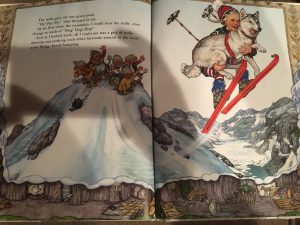Title: Trouble with Trolls

Author: Jan Brett
Illustrator: Jan Brett
Publisher and Year: G. P. Putnam’s Sons, 1992
Number of Pages: 30
Genre: Fantasy
Analysis: In Trouble with Trolls, a young girl Treva and her dog, Tuffi, like to go on hikes up the mountain and then to ski down the mountain. Whenever they go up the mountain they encounter trolls that try and take her dog. Each time Treva runs into a different troll, she uses manipulation in order to save her dog from the trolls.
This book can function as a window for an audience who does not know about mountains, hiking or dogs. This book gives an insight into what life is like in the mountains. However, another function could be a mirror because people who live near or in mountains and are used to hiking or other problems that may arise while hiking may see themselves throughout the book.
Perceptually, the words are easy to read and the length is just right per page. The images seem to stop or create their own framing around the words. Since this pattern within the text repeats itself, at first the images mirror the meaning of the text but as the pattern continues some of the images begin to add meaning to the text.
Structurally, each image is detailed and framed. The frame around each image is detailed as well. However, on some of the pages the images seem to be coming out of the frame. For example, the underground cave for the trolls comes out of the frame and allows the audience to feel part of the sneaky action with the trolls, while the framed pictures only allow the audience to see a glimpse into Treva’s world. The partially framed and unframed structure creates two different experiences, depending on what is first seen while looking at each page. The images that crawl out of the frame blend in which can go unnoticed while first reading the book. After re-reading the book, the reader picks up on the detail of the underground cave outside of the frame creating a more involved feeling with the book a second or third time reading it.

Ideologically, this book teaches a negative message and a positive lesson. First off, Treva is intelligent and creative. She uses problem solving skills and techniques that can be applicable and interesting for young children to read about. Students could learn how to use their creativity and problem solving skills to fix a situation. However, Treva’s intelligence and creativity is sneaky and she is manipulative of the trolls. Although teachers strive to teach problem solving skills to students, problem-solving skills should not be sneaky.
